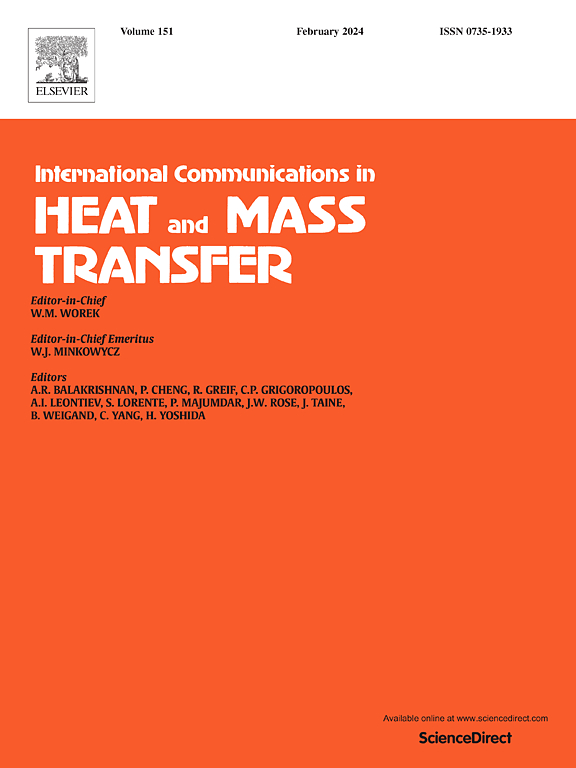Heat transfer enhancement by flow control with baffle optimization in vertical wall PCM
IF 6.4
2区 工程技术
Q1 MECHANICS
International Communications in Heat and Mass Transfer
Pub Date : 2025-07-01
DOI:10.1016/j.icheatmasstransfer.2025.109261
引用次数: 0
Abstract
The aim of this study was to improve heat transfer through flow control via optimized baffles with a gap in a PCM vertical wall system. Numerical simulation, performed for the baffles by varying the height of the PCM section and the gap length, was validated by experimental results. Analysis of the height of the PCM section with 1.5 mm gap showed that single enhanced circulation for each section reduces thermal stratification in the case of small section height, compared to the divided circulation in large section height. The divided flow includes circulation in the molten zone. In the fully molten zone, the temperature gradient was small, and the heat transfer rate was low, compared to those of the partially molten zone. For variations in gap length, the (1.5 and 2) mm gap cases increased the heat transfer rate, while larger gaps resulted in low heat transfer rate by weakened circulating flow. The 21 mm section height and 1.5 mm gap length showed the highest energy absorption rate. The results showed that efficient heat transfer to the PCM could be achieved by applying optimized baffles with a gap that could control the circulating flow and maximize the heat transfer.
竖壁PCM中挡板优化流动控制强化换热
本研究的目的是通过流动控制,通过优化挡板的间隙在PCM垂直壁系统中改善传热。通过改变PCM截面高度和间隙长度对折流板进行数值模拟,实验结果验证了数值模拟的正确性。对间隙为1.5 mm的PCM剖面高度的分析表明,与大剖面高度的分块环流相比,小剖面高度时每个剖面的单次强化环流减少了热分层。划分的流动包括熔融区的循环。与部分熔融区相比,完全熔融区温度梯度小,换热速率低。对于间隙长度的变化,(1.5和2)mm的间隙增加了换热率,而较大的间隙导致循环流动减弱,换热率降低。截面高度为21 mm、间隙长度为1.5 mm时,吸能率最高。结果表明,采用优化后的带间隙的折流板可以有效地控制循环流量并使换热最大化,从而实现对PCM的高效换热。
本文章由计算机程序翻译,如有差异,请以英文原文为准。
求助全文
约1分钟内获得全文
求助全文
来源期刊
CiteScore
11.00
自引率
10.00%
发文量
648
审稿时长
32 days
期刊介绍:
International Communications in Heat and Mass Transfer serves as a world forum for the rapid dissemination of new ideas, new measurement techniques, preliminary findings of ongoing investigations, discussions, and criticisms in the field of heat and mass transfer. Two types of manuscript will be considered for publication: communications (short reports of new work or discussions of work which has already been published) and summaries (abstracts of reports, theses or manuscripts which are too long for publication in full). Together with its companion publication, International Journal of Heat and Mass Transfer, with which it shares the same Board of Editors, this journal is read by research workers and engineers throughout the world.

 求助内容:
求助内容: 应助结果提醒方式:
应助结果提醒方式:


